2010 Devon GTX - Click above for high-res image gallery
When news of the Devon GTX first wafted our way, we didn't know what to think of it. Another bit of pretty vaporware being shown to attract investors? Another pet project from some megalomaniac with dreams of grandeur? Another American supercar boasting record-breaking performance with nothing but hot air to back up its claims? Or was it the real deal? Could Scott Devon and his team actually pull it off – could they deliver on the promise of building a truly great American supercar that could equal the world's finest?
Early reports showed that the Devon GTX would have the same power-to-weight ratio as the Ferrari Enzo with 650 horsepower propelling its 3,000 pounds, but the actual benchmark, we would later learn, was the Ferrari 599 GTB Fiorano. When the first pre-production car went out and set the production car lap record at Laguna Seca, it looked like they might not be bluffing about the numbers. And seeing the same car attract more than its fair share of attention from the highly jaded cognoscenti on the concept lawn at Pebble Beach made us think they might not be crazy after all. So did they pull it off? Did Devon actually succeed in building a car that could rival Maranello's front-engined supercar? We stopped by Aria Group, the Irvine-based specialty manufacturing facility that will be handling Devon production to find out. Follow the jump to see if the Devon GTX might just be the real thing.
Photos copyright ©2009 Frank Filipponio / Weblogs, Inc.
Walking into a room accessorized with two Devon GTX supercars, it's easy to think you are actually in a gallery. The cars are sculpture. When spy shots first showed that the finished car looked just like the earlier renderings, we were grateful. The styling tends to be polarizing, but we like it. When Scott Devon first saw the sketches, they had such an impact on him that he says he knew he had to build it.
While many supercars of the modern era follow a fairly predictable formula, Daniel Paulin's design takes both a step and a look back. With curves aplenty, the GTX emulates the coachwork you might see coming out of the great Italian design houses. That could be because Paulin is Swedish, and Scandinavians know a little something about curvy bodies. The shape is an odd blend of Euro panache with American muscle that somehow works really well in person.
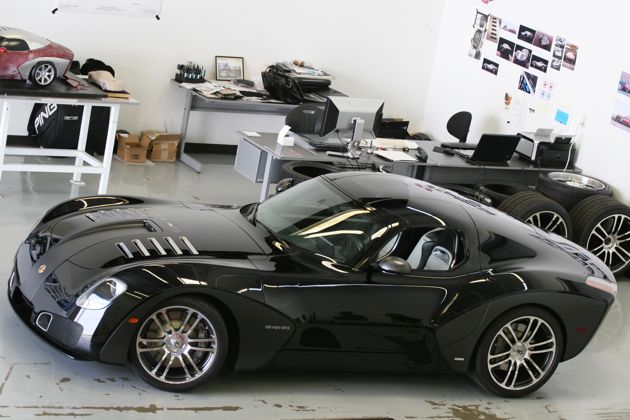
No lightly detuned LMP1 car with slats bought in bulk and wings jutting out from every surface, the Devon GTX is more of a super GT than an all-out supercar. That it happens to offer performance on par with those track-oriented supercars is almost an afterthought. In that way, it's a bit like the Bugatti Veyron – a visually polarizing bit of design that happens to be blindingly fast. The overall look is striking and sophisticated, with unique cues that help differentiate it from the pack. Although individual elements can be picked apart, the overall package is modern and tasteful and successfully translates Paulin's personal dream car sketches into reality. These were sketches he did while working at Ford of Europe, doodles he did while designing the C-Max among other things. These were the sketches that caught Scott Devon's eye.
It's a bit like the Bugatti Veyron – a visually polarizing bit of design that happens to be blindingly fast.
The long hood and short deck are partly due to coupe's Dodge Viper platform, and partly due to the fact that it just looks good. More about the Viper part in a bit, but aside from the windshield and general proportions, it's hard to see any Pentastar DNA in the exterior styling. While the mix of curves and angles gives the car a lot of latent energy, the glass-intensive roof gives it a certain restrained elegance. We see elements of the Alfa Romeo 8C and Panoz Esperante in the bodywork, but it really gels into something unique and exciting. The most controversial styling elements are probably the contrasting black fender panels (they might be chrome on some production cars), and the butterfly doors which are exotic and striking, but might be rethought before production.
You also might notice that the nose seems very smooth considering there's an 8.4-liter V10 under that sharply sloping bonnet. The company has been working hard on airflow to keep that shapely snout planted at speed, and everything else underhood cool as well. Development driver and Le Mans winner Justin Bell reports that the car is as stable as any race car he's driven at speed, although folks who really intend on tracking their cars might want to opt for the planned race package with a more aggressive front lip and the add-on rear wing seen at Laguna Seca. Although you can only see a bit of the diffuser out back, the whole undertray has been carefully sculpted in a wind tunnel to balance those needs.
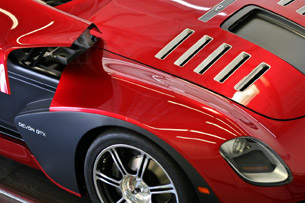
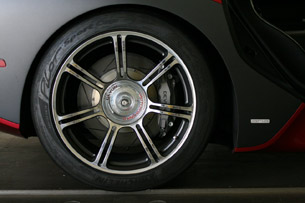
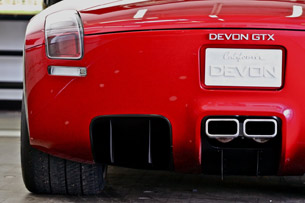
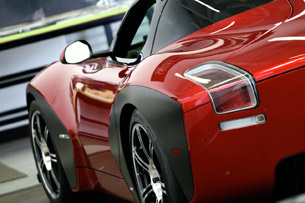
We like the look, especially in dark blue or black, although the red-and-chrome wind tunnel model is pretty sharp as well. Perhaps our affection for the classic French coachbuilders like Figoni et Falaschi makes us biased towards those elongated fender arches, which we see as a modern take on those '30s masterpieces. Blasphemous as it might seem, it's not hard for us to see the Devon as a modern Talbot-Lago T150-C or Bugatti T57 Atlantic Coupe. If we had to nitpick, we'd say the wheels are a bit of a letdown, and we'd swap those out for something a little less flashy.
The interior continues the theme with modern touches on a classic and tasteful design. It has a certain retro feel with simple aluminum surrounds breaking up the dark leather fields. The leather-swathed carbon-fiber seats are splendid and wouldn't look out of place in a museum. The McIntosh stereo system is a great touch too, but we think the 200-pound(!) amp behind the seats should be jettisoned as part of the race package.
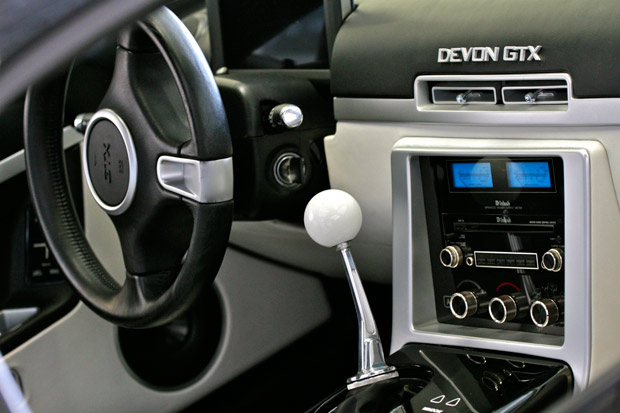
The steering wheel and LCD gauge cluster have garnered their fair share of criticism, but they are just for these pre-production prototypes, as the cars needed something to fulfill those duties during testing. While the final design of these features hasn't been nailed down, the rest of the interior packaging suggests that the Devon team will choose wisely. Naturally, we took the opportunity to lobby for proper analog gauges and got sage nods in return. The iPhone-like black console is also slated for a makeover, but one thing that will definitely stay is that big, meaty shifter.
No flappy paddles for this GT. Scott Devon wanted the GTX to be a drivers' car. No traction control, no driver selectable suspension settings, no Bluetooth integration. This is a car that is meant to reward driving skill, one that challenges you to test its limits, but is much more refined and predictable than something like the Viper. A modern day Cobra in a designer suit. Maybe even a throwback to the days of the gentleman racer where you could drive to the track, race hard all afternoon, and then stop off at a black tie affair to celebrate your win. The only snag might be trying to get in and out in a hurry.
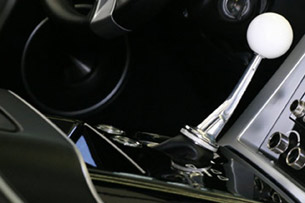
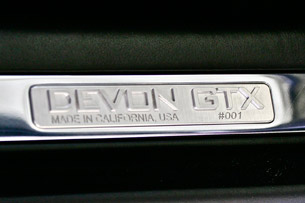
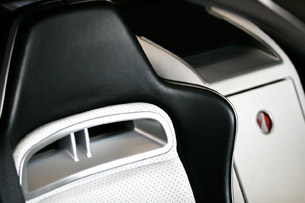
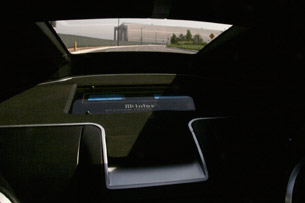
Those butterfly doors are very cool. They evoke memories of the Gullwing Mercedes and add a bit of endurance racer attitude to the car. The McLaren F1 leaps to mind. And let's be honest, it seems you need to have some kind of non-traditional doors these days if you want to get noticed in the crowded field of exotics. They go a long way toward separating this from off-the-rack sports cars like a Corvette or a Viper. They aren't very practical, however.
Particularly in profile, you can see that they account for nearly half of the total carbon fiber body. Not terribly heavy, mind you, but large. They also have a limited range of motion that makes it a bit tricky to enter the cockpit. We were assured that these weren't going to be the final door settings, and that conventional doors were still being considered. We like the butterflies. The way they integrate into that canopy is inspired. Just work on getting them to open a bit higher.
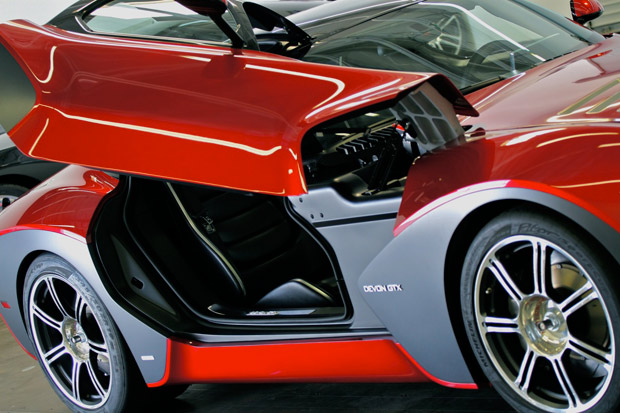
Before we get into the mechanical side of things, it's worth explaining where this car came from. For that we need to look at the company's founder and namesake, Scott Devon. Scott first came onto our radar when he was linked to Chrysler's sale of the Viper program several months ago. The Devon GTX renderings were being shown and because it was based on the Viper, it seemed fortuitous timing that Chrysler was looking to sell the brand. Scott put in a bid hoping to secure the tooling and space to build the Viper with the intent to offer the GTX as a premium version. If he had succeeded, the GTX might have been produced in larger numbers than the planned 36 units per year Devon is talking about now. The price might have been significantly lower as well. Instead, Chrysler rejected the offer and Devon turned to specialty manufacturer Aria Group in Irvine, California.
We rode in the car with the standard suspension, not the new one being developed with help from the military.
Aria has handled everything from design work to concept car crafting to small scale production runs like the Hurst Challenger. Their expertise made it possible to turn the initial concept sketches into a real driver in about 14 months. The bulk of the Devon team has been together for about two years, but that is still an amazingly short timeframe to go from paper to tarmac. A large manufacturer couldn't even come close to that quick of a turnaround. One reason they could move so swiftly is that they started with an already highly developed sports car. Yet as good as the Dodge Viper may be, there isn't much of it left after Devon gets a hold of it.
When they get a donor Viper, the team strips it to the bare chassis. The engine is upgraded and a new interior, suspension, carbon fiber superstructure and underbody are attached. The result, as we would soon learn, is a car that feels nothing like the car it is based on, and performs even better. The engine gets a bump from 600 hp to 650, and curb weight drops to around 3,000 pounds thanks in large part to the totally carbon fiber superstructure. About that – the quality of the carbon fiber work is amazing. That superstructure eliminates any of the squeaks and rattles that you'd find in a Viper and makes the car feel more like a Mercedes SLR McLaren than anything else. It might be too soon to suggest the SLR (or upcoming SLS) as a direct competitor, but that's how good this car feels. The structure feels so stiff but the suspension keeps the ride from being too harsh. And this was in the car with the standard suspension, not the new one being developed with help from the military.
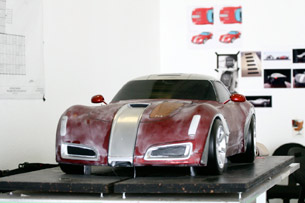
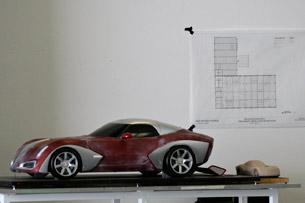
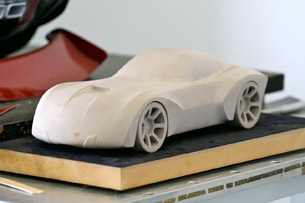
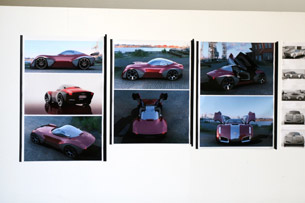
No kidding, the government is working on commercial applications for some suspension wizardry that the military has been using on their off-road vehicles. It essentially adjusts to road conditions instantaneously. When fully sorted, this optional Active Shock Damping Suspension promises to advance adjustable suspension technology by several orders of magnitude. For now, the suspension handles bumps and potholes pretty well and eliminates body roll full stop. It also keeps the meaty Michelins planted well enough to fully harness all of that power. Tires are Michelin Pilot Sport Cups, sized 295/30ZR18 on 18x10-inch wheels up front and 335/30ZR19 on 19x13-inchers out back. One inch larger wheels with Cup 2 rubber will be available as an option. While the team was justifiably gunshy about letting anyone else drive the car, we did convince Justin Bell to take us for a spin.
Think GT-R, Porsche Turbo or even, yes, Ferrari 599. Then think faster.
Because so many details are still being sorted before production officially begins in March of 2010, they didn't want us to get any wrong ideas about the possible setup. From what we felt riding shotgun, they needn't have worried. With the doors closed, the space is a bit snug at the hip and shoulder, but no more so than in a Viper. The amazing thing is that above the shoulders, that airy canopy lets in so much light that you feel like you're in a much larger car. We already mentioned the seats, but underway they felt even more impressive, with plenty of support all around. They hold you very well when the g-meter climbs as we found out on a couple of fast sweepers and through one delightful hairpin.
To say that the car is quick would be a gross misrepresentation. Mustangs are quick. Corvettes are quick. This thing is insane. Think GT-R, Porsche Turbo or even, yes, 599. Then think quicker. We didn't run any timed passes, but 0-60 mph seems to happen so quickly that you almost have to skip it and concentrate hard enough to notice when 100 goes by. The best part about those few short blasts were that they were entirely drama free. Well, Justin does know how to drive the car better than just about anyone on the planet, but there was very little wheelspin unless he called upon it for show. With all that power, the six-speed transmission almost seemed to have three gears too many. The car just connects, and suddenly we were at that place in the distance we had been seeing through the windshield moments earlier.

The other highlight of our brief foray onto the streets of California was the sound. While there was some wind noise coming into the cockpit (due no doubt to this being a pre-production car with about 5,000 test miles on it), the exhaust note was straight out of Le Mans. The Devon team somehow managed to get that big flatulent V10 to sound like a muscular V8 with two extra cylinders. Considering that the standard Viper exhaust note is a bit like that of a UPS truck, this was no mean feat. Seeing the smile on Bell's face the whole while we were cruising around really convinced us he was pleased with the car. For a guy who has driven a McLaren F1 at Le Mans, this is really saying something.
We got to talking about other cars for comparison's sake and eventually the Koenigsegg CCX came up. We both recalled how that car managed its power sans electronics so well. You could pitch it at a turn and nail the throttle well before it was prudent, and just reel in the mild oversteer with subtle modulation of the steering wheel and a judicious right foot. That's exactly how the Devon seems to respond. It just settles into an arc, hooked up and launched. Justin said that one reason it drives so well is because the car has an amazing amount of downforce, well balanced between front and rear. That led to a discussion of those lap times everyone has been talking about.
First of all, they wanted to make it clear that they never took the car to the Nürburgring, and that if and when they ever do, nobody on the team believes the car will best the Radical SR8's record. The Viper ACR possibly, but not the Radical. The Radical isn't seen as competition. Also, they did set a record at Laguna Seca, but that was just a happy byproduct of a shakedown run.
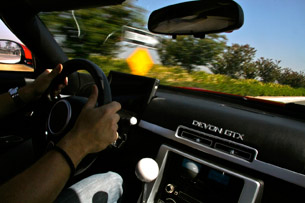
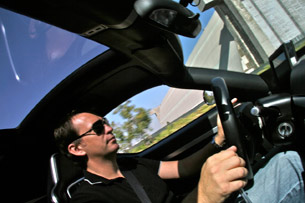
Justin walked us through that Laguna Seca session: The car had been promised for Pebble Beach and a few parade laps. Team Devon had reserved the track a week before the big unveiling to get some promotional video shot. When they got there, they ran a couple of reconnaissance laps before Justin saw a trickle of water under the car. They discovered that a weld inside the radiator had come undone. As the hours (and dollars) ticked away, they sat and waited while a new radiator was located. With their track time set to expire, they desperately tried to get the new one installed so that the day wouldn't be a total write-off. They finished right at the buzzer and convinced track management to grant them another half hour. After another handful of laps to make sure that everything was in order, the film crew finally told Justin it was now or never, to just uncork it and run it as hard as he could because it was getting late. It was like a qualifying lap and that one lap turned out to be a record-breaker. The team reckons that they could go back and best that time by a good margin.
Justin is pretty sure of that mainly because he feels so confident driving the car. One of the reasons for that confidence is all of the aero work they've done with top aerodynamicist, Dr. Joe Katz, down in San Diego. Another is the phenomenal brakes. The car uses brakes very similar to the ones used on the Speed GT Porsches run by GMG and others. Bell says that those StopTechs have absolutely no fade and that they stop the car so well, he can push harder and harder every lap, assured that the brakes will be there when he needs them. He says it's the first road car he pushes as hard as a race car with zero fear – and his daily driver was an SLR last we checked. He gave us a taste of that braking performance on our tour of the area and they definitely scrub off speed quickly with no drama. Strong brakes, an incredibly stiff structure, a well-tuned suspension, aerodynamics that keep the car planted and that eager powerplant make for a potent package.
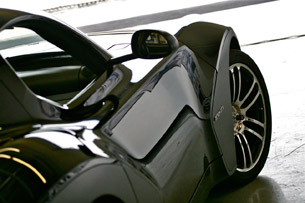
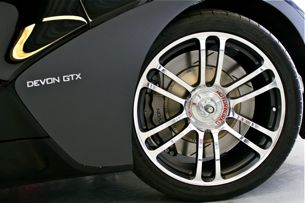
We regret not getting some time behind the wheel, but it was still fun to get such an inside look at what goes into the making of a supercar. Production of the Devon GTX is set to start in March of next year with an MSRP of $500,000. That's a lot of coin for an unproven name, but we think they have a pretty good chance at success. The workmanship looks top notch, the performance should put the GTX in the same league as cars costing at least as much, and they only plan to move 36 cars a year. That's fewer cars than Bugatti produces annually. The company has already had serious inquiries from a number of interested customers, including professional athletes and celebrities, and we suppose many more will join the list when the car gets fully sorted and returns to the track. Even though it doesn't quite match the luxury and sophistication of the benchmark Ferrari 599 at this point, it does have a lot of unique features, including bold and elegant styling, world-class performance and the appeal of being All-American.
Producing cars on such a small scale also means that Devon Motorworks will be able to customize each car much more easily. Things like wheel openings and those contrasting flats can be altered to taste. Targas and convertibles should be fairly easy to do as well. If all goes well with the GTX, Devon also plans to get into motorcycles and lifestyle accessories too, like the watches you can see in the studio photos. Why? Because Scott likes bikes and watches, simple as that.
Just like he did when he saw Daniel Paulin's sketches, Scott Devon moves on his passions and makes them happen. Only time will tell if the GTX is a success, but his team really knows what it's doing and they have a product that fills a unique niche in a most spectacular way. We'll reserve final judgment until we can actually get behind the wheel of one for ourselves, however. Dark blue with black fenders, active suspension and the smaller aero package, please.
Photos copyright ©2009 Frank Filipponio / Weblogs, Inc.

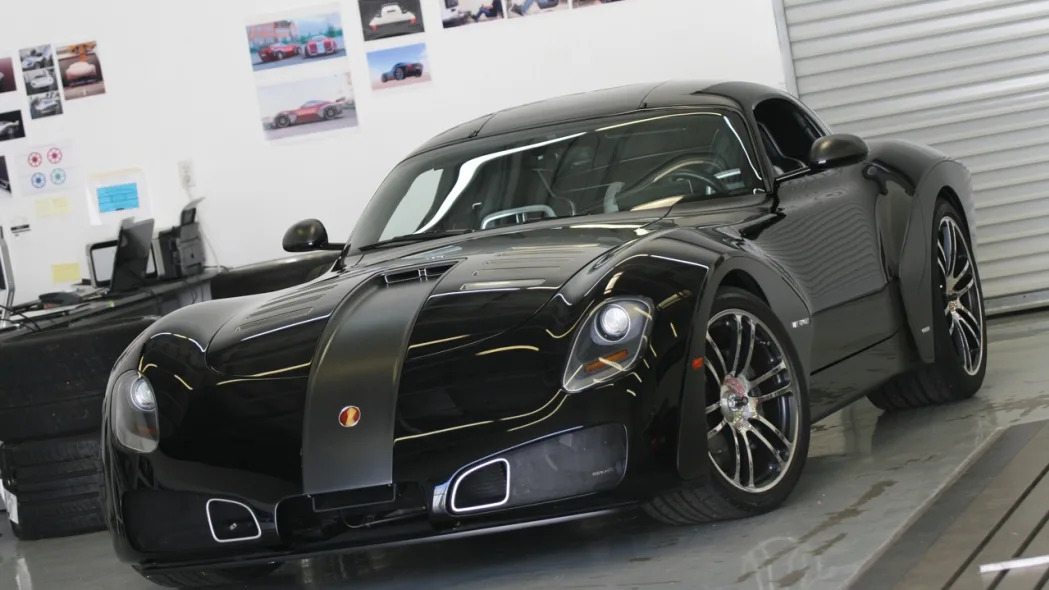

Sign in to post
Please sign in to leave a comment.
Continue